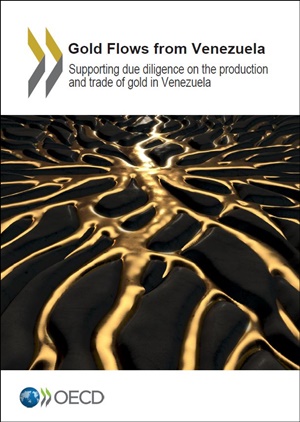Gold flows from Venezuela: supporting due diligence on the production and trade of gold
|
Date of publication in English 8 September 2021
|
About the reportA new OECD report examines risks of corruption, conflict financing and money laundering linked to gold flows from Venezuela. As pointed out by this and other reports, all risks of adverse impacts listed in the OECD Guidance for Responsible Mineral Supply Chains (human rights abuses, conflict financing or financial crimes) are reported to be prevalent across supply chains of gold from Venezuela. Gold flows within Venezuela can be categorized under two broad headings: centralised and dispersed. In contrast, dispersed flows are those that leave the country from mining areas by various other routes. The Venezuelan military and political elites, Colombian militant groups, and domestic gangs are reported to be key actors in both categories of domestic gold flows. Gold from dispersed flows departing Venezuela appears to be laundered primarily within the Latin America and Caribbean region, mainly in one or more key regional transit hubs. Laundering networks can, however, extend across the globe and actors connected in other continents. Since many of the high-risk gold flows out of Venezuela involve regional transit hubs as well as distant transit countries and destination markets, any approach to mitigating the risks tied to Venezuelan gold should include regional and international coordination among both government and industry actors. This consideration is heightened by the evident involvement of transnational criminal organisations and designated terrorist groups in exploiting mining communities, extracting gold and laundering it into the legitimate supply chain. The resulting picture is preliminary but also revealing. The role of the maritime space in high-risk gold flows needs more attention; so does the role played by Free Trade Zones (FTZs) in facilitating gold flows and related financial crimes. A few recommendations on how best to address the risks that characterise Venezuelan gold flows conclude the report.
Leer informe Flujos de oro desde Venezuela, apoyo a la diligencia debida en la producción y comercio de oro en Venezuela en español
About the OECD Due Diligence Guidance Responsible Supply Chains of Minerals from Conflict-Affected and High-Risk Areas The OECD Due Diligence Guidance for Responsible Supply Chains of Minerals from Conflict-Affected and High-Risk Areas provides step-by-step recommendations endorsed by governments for global responsible supply chains of minerals in order for companies to respect human rights and avoid contributing to conflict or bribery through their mineral or metal purchasing decisions and practices. This Guidance is for use by any company in the mineral supply chain potentially sourcing minerals or metals from conflict-affected and high-risk areas. The OECD Guidance is global in scope, and applies to all mineral supply chains. Find out more about the Guidance and the OECD Responsible Minerals Implementation Programme
See also |
Related Documents


